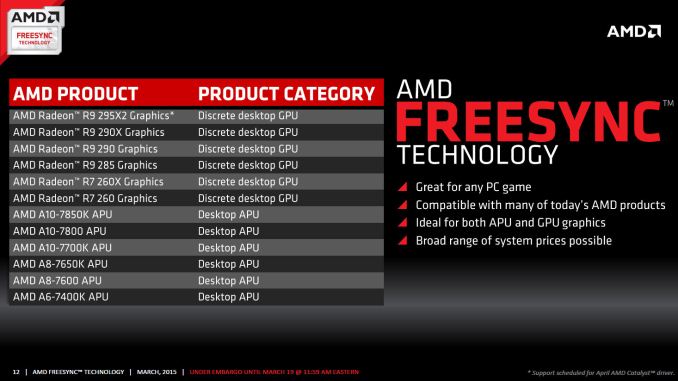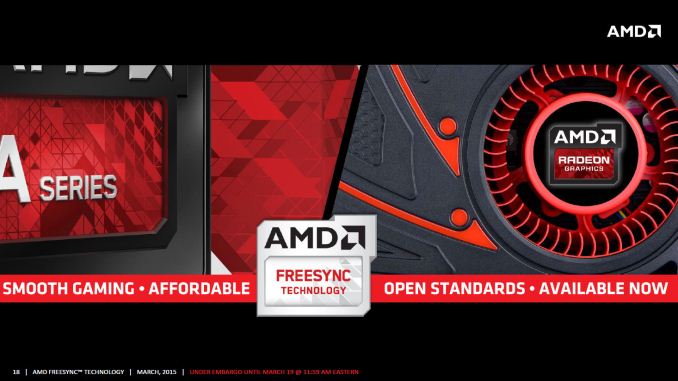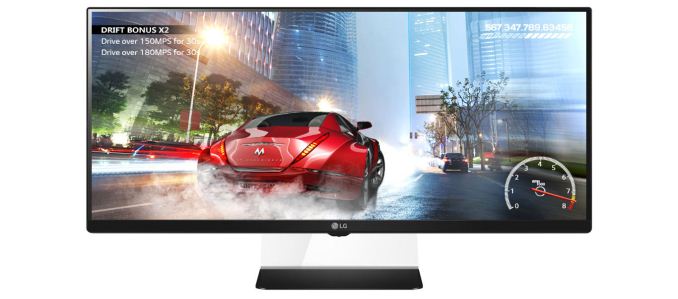The AMD FreeSync Review
by Jarred Walton on March 19, 2015 12:00 PM ESTClosing Thoughts
It took a while to get here, but if the proof is in the eating of the pudding, FreeSync tastes just as good as G-SYNC when it comes to adaptive refresh rates. Within the supported refresh rate range, I found nothing to complain about. Perhaps more importantly, while you’re not getting a “free” monitor upgrade, the current prices of the FreeSync displays are very close to what you’d pay for an equivalent display that doesn’t have adaptive sync. That’s great news, and with the major scaler manufacturers on board with adaptive sync the price disparity should only shrink over time.
The short summary is that FreeSync works just as you’d expect, and at least in our limited testing so far there have been no problems. Which isn’t to say that FreeSync will work with every possible AMD setup right now. As noted last month, the initial FreeSync driver that AMD provided (Catalyst 15.3 Beta 1) only allows FreeSync to work with single GPU configurations. Another driver should be coming next month that will support FreeSync with CrossFire setups.
Besides needing a driver and FreeSync display, you also need a GPU that uses AMD’s GCN 1.1 or later architecture. The list at present consists of the R7 260/260X, R9 285, R9 290/290X/295X2 discrete GPUs, as well as the Kaveri APUs – A6-7400K, A8-7600/7650K, and A10-7700K/7800/7850K. First generation GCN 1.0 cards (HD 7950/7970 or R9 280/280X and similar) are not supported.
All is not sunshine and roses, however. Part of the problem with reviewing something like FreeSync is that we're inherently tied to the hardware we receive, in this case the LG 34UM67 display. Armed with an R9 290X and running at the native resolution, the vast majority of games will run at 48FPS or above even at maximum detail settings, though of course there are exceptions. This means they look and feel smooth. But what happens with more demanding games or with lower performance GPUs? If you're running without VSYNC, you'd get tearing below 48FPS, while with VSYNC you'd get stuttering.
Neither is ideal, but how much this impacts your experience will depend on the game and individual. G-SYNC handles dropping below the minimum FPS more gracefully than FreeSync, though if you're routinely falling below the minimum FreeSync refresh rate we'd argue that you should lower the settings. Mostly what you get with FreeSync/G-SYNC is the ability to have smooth gaming at 40-60 FPS and not just 60+ FPS.
Other sites are reporting ghosting on FreeSync displays, but that's not inherent to the technology. Rather, it's a display specific problem (just as the amount of ghosting on normal LCDs is display specific). Using higher quality panels and hardware designed to reduce/eliminate ghosting is the solution. The FreeSync displays so far appear to not have the same level of anti-ghosting as the currently available G-SYNC panels, which is unfortunate if true. (Note that we've only looked at the LG 34UM67, so we can't report on all the FreeSync displays.) Again, ghosting shouldn't be a FreeSync issue so much as a panel/scaler/firmware problem, so we'll hold off on further commentary until we get to the monitor reviews.
One final topic to address is something that has become more noticeable to me over the past few months. While G-SYNC/FreeSync can make a big difference when frame rates are in the 40~75 FPS range, as you go beyond that point the benefits are a lot less clear. Take the 144Hz ASUS ROG Swift as an example. Even with G-SYNC disabled, the 144Hz refresh rate makes tearing rather difficult to spot, at least in my experience. Considering pixel response times for LCDs are not instantaneous and combine that with the way our human eyes and brain process the world and for all the hype I still think having high refresh rates with VSYNC disabled gets you 98% of the way to the goal of smooth gaming with no noticeable visual artifacts (at least for those of us without superhuman eyesight).
Overall, I’m impressed with what AMD has delivered so far with FreeSync. AMD gamers in particular will want to keep an eye on the new and upcoming FreeSync displays. They may not be the “must have” upgrade right now, but if you’re in the market and the price premium is less than $50, why not get FreeSync? On the other hand, for NVIDIA users things just got more complicated. Assuming you haven’t already jumped on the G-SYNC train, there’s now this question of whether or not NVIDIA will support non-G-SYNC displays that implement DisplayPort’s Adaptive Sync technology. I have little doubt that NVIDIA can support FreeSync panels, but whether they will support them is far less certain. Given the current price premium on G-SYNC displays, it’s probably a good time to sit back and wait a few months to see how things develop.
There is one G-SYNC display that I’m still waiting to see, however: Acer’s 27” 1440p144 IPS (AHVA) XB270HU. It was teased at CES and it could very well be the holy grail of displays. It’s scheduled to launch next month, and official pricing is $799 (with some pre-orders now online at higher prices). We might see a FreeSync variant of the XB270HU as well in the coming months, if not from Acer than likely from some other manufacturer. For those that work with images and movies as well as playing games, IPS/AHVA displays with G-SYNC or FreeSync support are definitely needed.
Wrapping up, if you haven’t upgraded your display in a while, now is a good time to take stock of the various options. IPS and other wide viewing angle displays have come down quite a bit in pricing, and there are overclockable 27” and 30” IPS displays that don’t cost much at all. Unfortunately, if you want a guaranteed high refresh rate, there’s a good chance you’re going to have to settle for TN. The new UltraWide LG displays with 75Hz IPS panels at least deliver a moderate improvement though, and they now come with FreeSync as an added bonus.
Considering a good display can last 5+ years, making a larger investment isn’t a bad idea, but by the same token rushing into a new display isn’t advisable either as you don't want to end up stuck with a "lemon" or a dead technology. Take some time, read the reviews, and then find the display that you will be happy to use for the next half decade. At least by then we should have a better idea of which display technologies will stick around.













350 Comments
View All Comments
chizow - Friday, March 20, 2015 - link
Yeah np, 2nd paragraph after the CCC Picture, it clearly states FreeSync panels begin exhibiting ghosting bleow 60Hz.https://translate.google.com/translate?sl=auto&...
You can thank me later for saving you $500+ on a 1st Gen FreeSync panel with ghosting problems that would frankly make it unusable to most.
I am sure we will see more reviews once reviewers actually get samples they can keep and aren't forced to use in AMD's controlled test environment...
silverblue - Saturday, March 21, 2015 - link
I said plural only because you implied it. More links still required.chizow - Saturday, March 21, 2015 - link
You can use google just as well as I can, I am sure. 2 links are plenty, especially when they actually give photo evidence of the problem.chizow - Monday, March 23, 2015 - link
Another confirmation of the problem from Forbes, with quotes from Petersen:http://www.forbes.com/sites/jasonevangelho/2015/03...
The fact Jarred and AT not only missed this, but have actively made excuses/denied it is pretty appalling as more and more reviewers are making note of the ghosting and flickering problems with FreeSync.
anubis44 - Tuesday, March 24, 2015 - link
@chizow: "Read some actual reviews that clearly show right now FreeSync is the inferior solution."You mean, as opposed to all the 'virtual' reviews we've been reading that all say the same thing: that FreeSync does exactly what G-Sync does, except for free? Clearly, a green goblin lover like yourself must respect techreport.com, a blatantly pro-nVidia website plain and simple, and even their response to FreeSync? I quote Scott Wasson:
"Now, I have only had a few hours with the BenQ XL2730Z (our review sample arrived yesterday afternoon), but my first impressions are just this: AMD has done it. They've replicated that sense of buttery smooth animation that a fast G-Sync display will get you, and they've done it in a way that squeezes the extra costs out of the monitors. This is a very good thing."
I'll repeat that operative part of the quote so you can't possibly overlook or ignore it. AMD has "DONE IT. They've REPLICATED THAT SENSE OF BUTTERY SMOOTH ANIMATION that a fast G-Sync display will get you, and they've done it in a way that SQUEEZES THE EXTRA COSTS OUT OF THE MONITORS."
This is all that the vast legions of gamers are going to care about: same buttery smooth performance, less cost. QED.
chizow - Tuesday, March 24, 2015 - link
Yeah, they are virtual reviews, done in controlled test environments in a limited period of time just as noted in that review. Now that actual live samples are coming in however, a LOT of problems are creeping up outside of the controlled test environments.And before you attack the author's credibility, as I'm sure you will, keep in mind this guy has been a huge AMD advocate in the past:
http://www.forbes.com/sites/jasonevangelho/2015/03...
"Note to readers: I have seen this firsthand on the Acer FreeSync monitor I’m reviewing, and PC Perspective noticed it with 2 additional FreeSync monitors, the BenQ XL2730Z and LG 34UM67. To illustrate the problem they recorded the aforementioned monitors running AMD’s Windmill demo, as well as the same demo running on a G-Sync enabled Asus ROG Swift. Ignore the stuttering you see (this is a result of recording at high speed) and pay attention to the trailing lines, or ghosting. I agree that it’s jarring by comparison."
anubis44 - Tuesday, March 24, 2015 - link
@maximumGPU: Oh, but chizow DOES believe it. He believes that the green goblin on the box is the hallmark of quality, and that nVidia NEVER makes any mistakes, NEVER rips off its customers, and NEVER cheats or lies, or acts deceptively, because 'it's all business'. In other words, he's a sociopath. He BELIEVES G-Sync MUST be better than FreeSync because there's a green goblin-labelled chip in the G-Sync monitor that MUST be doing SOMETHING the FreeSync monitor just cannot do. It just HAS to be better, because he PAID for it. LOLchizow - Tuesday, March 24, 2015 - link
Who cares about all that noise? They still offer the best product at any given price point if you can afford a slightly better product. Only sycophants like you go into the stupid and inane morality of it, same way you begrudge Intel for putting their boot to AMD's neck in the CPU market.Buy what gives you the best product for your money and needs, who cares about the rest.
medi03 - Thursday, March 19, 2015 - link
GSync is a shameless attempt to ban competition.AMD couldn't use it even if it would PAY for it.
On the contrary, FreeSync, being VESA standard, can be freely used by any GPU manufacturer, including Intel and nVidia.
Frenetic Pony - Thursday, March 19, 2015 - link
It's adaptive sync but worse in every way. What is possibly good about it?